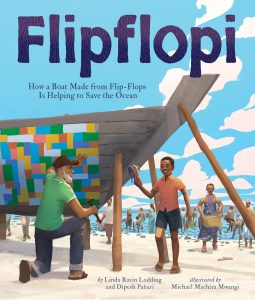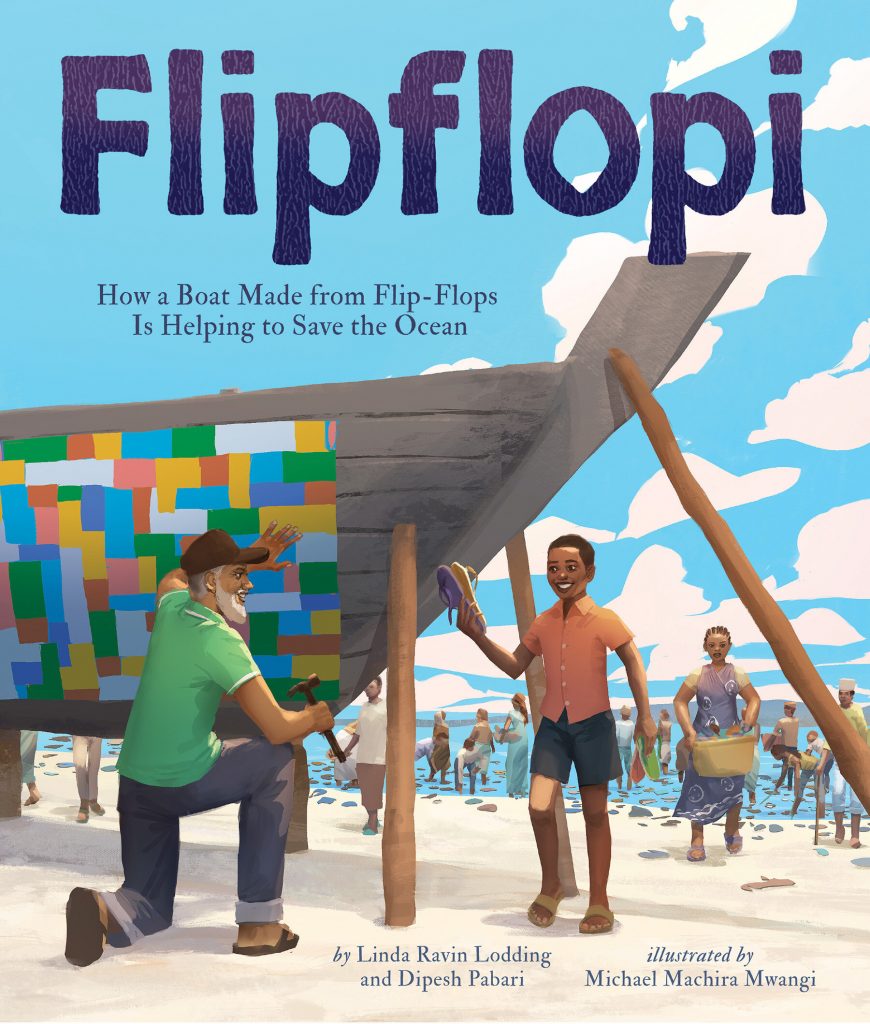Q&A Authors: Linda Lodding & Dipesh Pabari

Authors Linda Lodding & Dipesh Pabari answer our questions about their new book from Beaming Books, Flipflopi: How a Boat Made from Flip-Flops Is Helping to Save the Ocean.
Give us an elevator pitch about your book. What is Flipflopi about?
Flipflopi: How a Boat Made from Flip-Flops Is Helping to Save the Ocean is a picture book based on the true story of the Kenyan dhow boat, Flipflopi, that was made from 10 tonnes of recycled plastic waste and 30,000 flip-flops washed up upon the shores of Lamu. But this is also the story of one boy, his grandfather, and their entire community who came together to tackle the issue of plastic pollution. This story demonstrates how innovation, creativity, and determination can transform plastic pollution into something useful… and beautiful!
This is a fictionalized account of the true story of the dhow boat Flipflopi + one Kenyan community’s response to plastic pollution. Dipesh, tell us more about the Flipflopi Project. How did you get involved?
Dipesh: The FlipFlopi was born from Ben Morison, a school friend who, like me, worked in tourism. Ben realized that our glittering white sandy beaches were not glittering with white sand but glittering with lots of plastic litter. He wanted to do something big, different, unique, inspiring, and rooted in our East African heritage. His idea was to build a dhow, a traditional sailing vessel that has existed for thousands of years on the Indian Ocean. But he wanted to build the boar entirely from recycled plastic. Searching for someone adventurous enough to embark on this venture, Ben met Ali Skanda, the other co-founder who is based in Lamu, Kenya. Ali always says, ‘Everything is possible’ in Kiswahili. When Ben approached me with this wonderful, wild, and crazy idea, it resonated with my 15-year obsession with combating plastic pollution. Together, we embarked on the FlipFlopi journey. We gathered plastics from across the Kenyan coastline and over 30,000 flip-flops from Kenya’s beaches to construct the boat, employing local artisans to create a colorful patchwork skin that adorns its hull. This colorful eyecatcher is how we came up with the name FlipFlopi!

Linda, how did you hear about the Flipflopi Project and what made you initially think this would make a great picture book?
Linda: I discovered the Flipflopi Project through a National Geographic short film titled “A Boat Made From Plastic Waste is One of Kenya’s Solutions to a Global Problem.” I was fascinated by the ingenious combination of traditional boat-building techniques with plastic waste to address a pressing global issue. However, it was the boat’s colorful patchwork exterior that truly tugged on my writer’s heart. As a picture book writer who thinks visually, I was instantly drawn to the illustrative elements of this project. Who could resist such a charming, colorful boat with such a powerful message?! I also knew that the story would resonate with today’s young generation, who are so engaged with climate issues. Flipflopi serves as a reminder that each child has the power to make a difference and take responsibility for our planet.
You live on different continents… What was the process of working together from a distance? What came easy? And what did you find challenging about fleshing out this story?
Linda: The beauty of technology made our collaboration easy; plus, even though we are thousands of miles apart, we only have a 1-hour time difference! However, most challenging for me, was the fact that I wasn’t on the ground in Lamu and, initially, I relied on my research and all the wonderful photos, videos, and stories produced by the Flipflopi communication team to try to get a feel for the scale of the issue. Fortunately, Dipesh contributed not only with the facts of the project but he also infused the story with details to create an authentic story. For example, I love that he added-in Swahili words such as takataka, which means “trash”; these details added an extra layer of richness to the narrative.
What do you hope young readers take away from the book?
Linda: We’ve shared this book with so many children of all ages, and each takes away something different. For the very young, they connect with Juma and his excitement to build a boat with his grandfather, Babu Ali. Older children are fascinated by the fact that this boat – a marvel of technology and beauty – was made with tons of plastic trash collected from the shores. The children in Lamu have been so excited to see their story – and their community – held up as an example of what can happen when awareness turns to action and when everyone works together. But, regardless of age, we hope Flipflopi will inspire and empower every child to learn that we’re responsible for our planet and can truly make a difference.
Learn more about Flipflopi: How a Boat Made from Flip-Flops Is Helping to Save the Ocean (Beaming Books. 9781506486406. March 14, 2023).
About the Authors
Linda Ravin Lodding is an award-winning author of eight picture books, including Painting Pepette. When she’s not writing, Linda is head of communications for a children’s rights organization that focuses on a child’s right to a healthy environment. Originally from New York, she now lives in Sweden.
Dipesh Pabari is an eco-leader, educator, waste plastic innovator, and one of the founders of the Flipflopi Expedition. He lives in Kenya.
Check out more Guest Q&As with our community!

